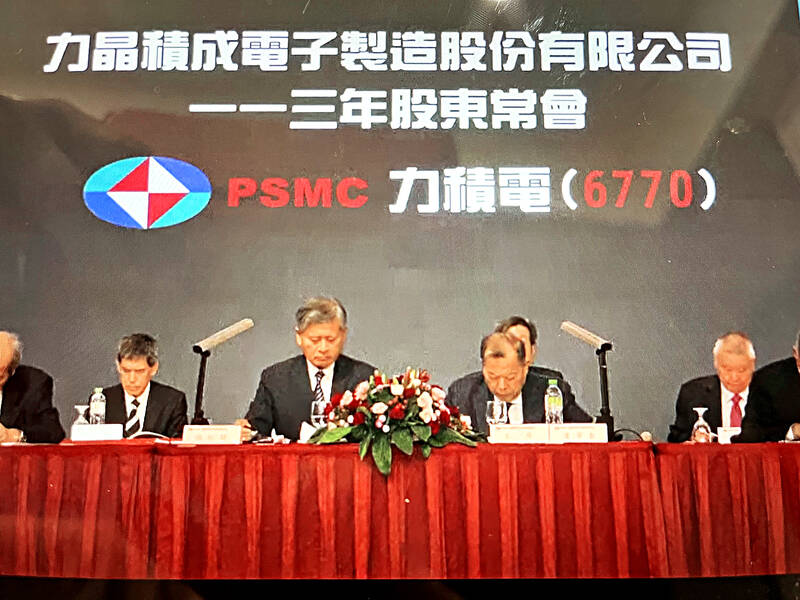Contract chipmaker Powerchip Semiconductor Manufacturing Corp (力積電) yesterday said revenue would gradually pick up in the second half of this year due to restocking demand and an optimized product portfolio in response to growing demand for artificial intelligence (AI) applications.
The Hsinchu-based chipmaker has been adjusting its product portfolios for the past two years with the aim of meeting demand from major customers, who were diversifying from China amid geopolitical risks, Powerchip president Brian Shieh (謝再居) told shareholders during the company’s annual general meeting in Hsinchu yesterday.
Powerchip is also developing a new process technology to make power management chips, vying for business opportunities in the Internet of Things (IoT), AI, high-performance computing and electric vehicle arenas, he said.

Photo: Grace Hung, Taipei Times
“With all those preparations and product line adjustments, we hope the effect will emerge from the second half to the first half of next year after customers reduce their inventory to normal levels,” Shieh said. “With capacity from the new fab in [Miaoli County’s] Tongluo Township (銅鑼) coming online in the second half, we anticipate the company’s revenue would gradually recover.”
Powerchip’s revenue fell 5.3 percent year-on-year to NT$14.5 billion (US$449 million) in the first four months of this year, following a 42 percent annual decline to NT$44 billion last year due to inventory adjustments.
Through product optimization, Powerchip is also looking to fend off rising competition from Chinese chipmakers, Shieh said.
China’s biggest chipmaker, Semiconductor Manufacturing International Corp (中芯), and Nexchip Semiconductor Corp (晶合) are major rivals to Powerchip.
Chinese companies expanded their capacity last year to produce display ICs, CMOS image sensors and power management chips using mature process technologies, but they had to drastically slash prices to compete for market share, Powerchip said.
Powerchip is also developing advanced “wafer-on-wafer” packaging technology as demand for devices such as PCs and smartphones with generative AI applications increases, Shieh said.
Powerchip plans to expand its product offerings to match customers’ demand for “single-level-cell” NAND and high-density NOR flash memory chips used in networking, mobile phones, IoT and computer peripherals, he said.
The company also plans to produce gallium nitride chips by rejuvenating its less-advanced 8-inch fabs, as well as power semiconductors including metal-oxide-semiconductor field-effect transistors and insulated gate bipolar transistors, he added.
Powerchip shareholders yesterday approved a proposal not to pay a cash dividend after the chipmaker lost NT$1.6 billion, or losses per share of NT$0.4, last year.
The company also booked NT$10.3 billion in idled manufacturing equipment losses and expenditures of NT$2.4 billion for the opening of the new fab in Tongluo Township.
The company last month said that it was approaching the break-even level last quarter as customers have reduced their inventory of chips used in consumer electronics such as smartphones, PCs and TVs to healthy levels.
Automotive and industrial chips were still in the process of inventory digestion, it said.

Taiwan Semiconductor Manufacturing Co (TSMC, 台積電) last week recorded an increase in the number of shareholders to the highest in almost eight months, despite its share price falling 3.38 percent from the previous week, Taiwan Stock Exchange data released on Saturday showed. As of Friday, TSMC had 1.88 million shareholders, the most since the week of April 25 and an increase of 31,870 from the previous week, the data showed. The number of shareholders jumped despite a drop of NT$50 (US$1.59), or 3.38 percent, in TSMC’s share price from a week earlier to NT$1,430, as investors took profits from their earlier gains

In a high-security Shenzhen laboratory, Chinese scientists have built what Washington has spent years trying to prevent: a prototype of a machine capable of producing the cutting-edge semiconductor chips that power artificial intelligence (AI), smartphones and weapons central to Western military dominance, Reuters has learned. Completed early this year and undergoing testing, the prototype fills nearly an entire factory floor. It was built by a team of former engineers from Dutch semiconductor giant ASML who reverse-engineered the company’s extreme ultraviolet lithography (EUV) machines, according to two people with knowledge of the project. EUV machines sit at the heart of a technological Cold

Taiwan’s long-term economic competitiveness will hinge not only on national champions like Taiwan Semiconductor Manufacturing Co. (TSMC, 台積電) but also on the widespread adoption of artificial intelligence (AI) and other emerging technologies, a US-based scholar has said. At a lecture in Taipei on Tuesday, Jeffrey Ding, assistant professor of political science at the George Washington University and author of "Technology and the Rise of Great Powers," argued that historical experience shows that general-purpose technologies (GPTs) — such as electricity, computers and now AI — shape long-term economic advantages through their diffusion across the broader economy. "What really matters is not who pioneers

TAIWAN VALUE CHAIN: Foxtron is to fully own Luxgen following the transaction and it plans to launch a new electric model, the Foxtron Bria, in Taiwan next year Yulon Motor Co (裕隆汽車) yesterday said that its board of directors approved the disposal of its electric vehicle (EV) unit, Luxgen Motor Co (納智捷汽車), to Foxtron Vehicle Technologies Co (鴻華先進) for NT$787.6 million (US$24.98 million). Foxtron, a half-half joint venture between Yulon affiliate Hua-Chuang Automobile Information Technical Center Co (華創車電) and Hon Hai Precision Industry Co (鴻海精密), expects to wrap up the deal in the first quarter of next year. Foxtron would fully own Luxgen following the transaction, including five car distributing companies, outlets and all employees. The deal is subject to the approval of the Fair Trade Commission, Foxtron said. “Foxtron will be